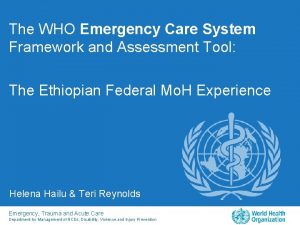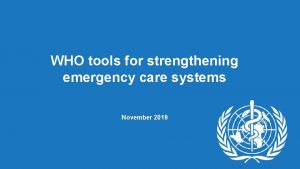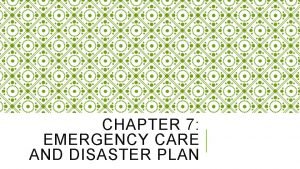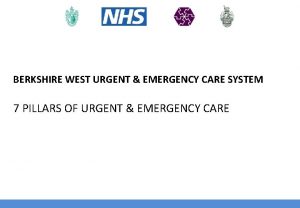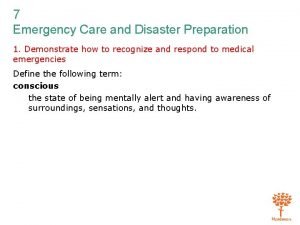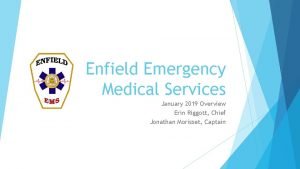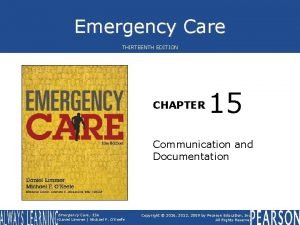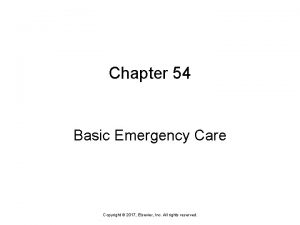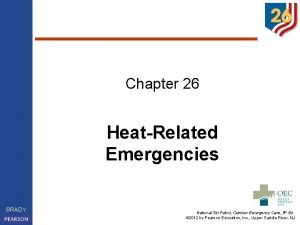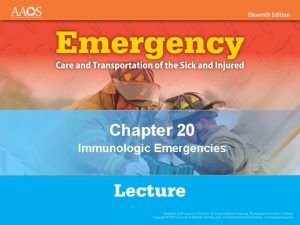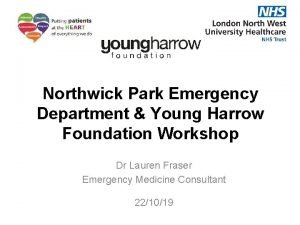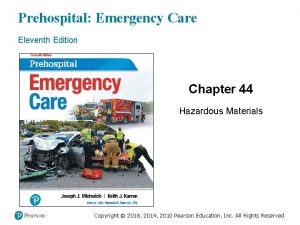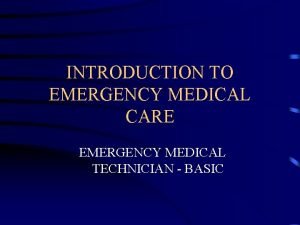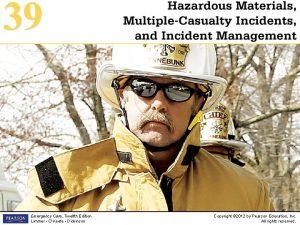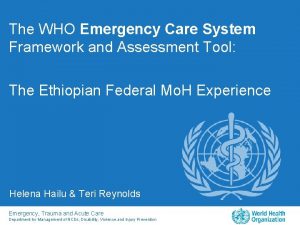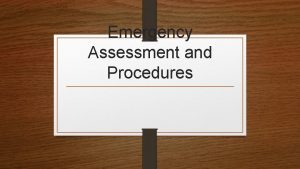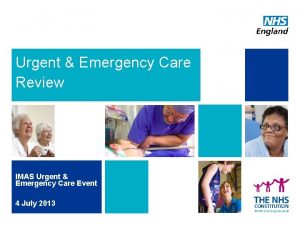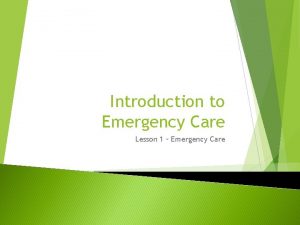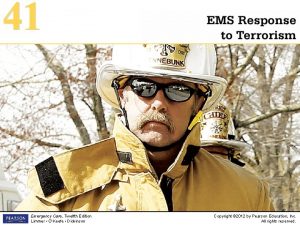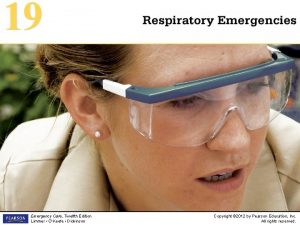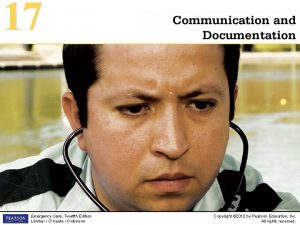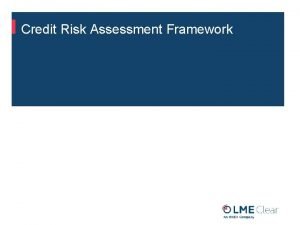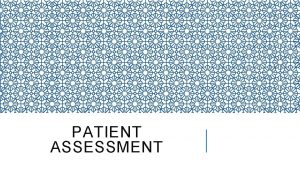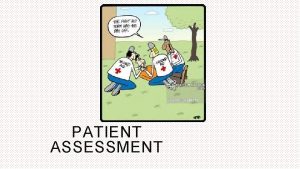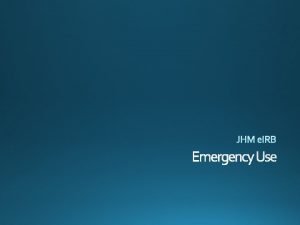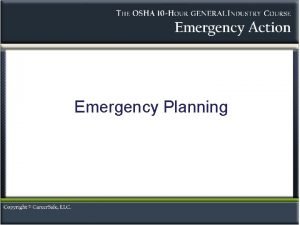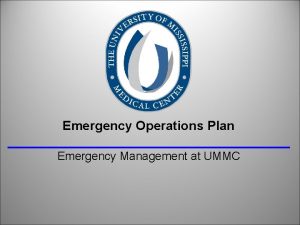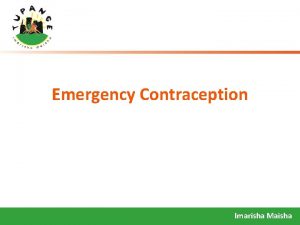The WHO Emergency Care System Framework and Assessment























- Slides: 23

The WHO Emergency Care System Framework and Assessment Tool: The Ethiopian Federal Mo. H Experience Helena Hailu & Teri Reynolds Emergency, Trauma and Acute Care Department for Management of NCDs, Disability, Violence and Injury Prevention

Calls on member states and WHO to assess, establish and monitor integrated prehospital and facility-based emergency care systems… Urges Member States “to identify and prioritize a core set of emergency and essential surgery and anaesthesia services at the primary health care and first-referral hospital level…” Emergency, Trauma and Acute Care Department for Management of NCDs, Disability, Violence and Injury Prevention

Emergency, Trauma and Acute Care Department for Management of NCDs, Disability, Violence and Injury Prevention

Emergency Care for the SDGs 3. 1 Reduce by three quarters, between 2015 and 2030, the maternal mortality ratio Treatment for obstetric emergencies 3. 2 Reduce by three quarters, between 2015 and 2030, the under-five mortality rate Treatment for acute paediatric conditions including diarrhea and pneumonia 3. 3 Reverse the incidence of malaria and other major diseases and reduce deaths caused by half by 2030 Treatment of acute infections and sepsis 3. 4 By 2030, reduce by one-third premature mortality from NCDs Treatment of acute exacerbations of NCDs 3. 5 Strengthen the treatment of substance abuse Emergency care and harm reduction interventions 3. 6 Halve the number of global road traffic crash fatalities and serious injuries by 2020 Post-crash emergency care 3. 8 Achieve universal health coverage including financial risk protection and access to quality essential healthcare Emergency care is an essential component of universal health care 3. 9 By 2030, substantially reduce the number of deaths and illnesses from hazardous chemicals Treatment for acute exposure to hazardous materials 11. 5 By 2030, significant reduce the number of deaths caused and people affected by disasters Disaster preparedness and response for resilient health systems 16. 1 Significantly reduce all forms of violence and related death rates everywhere Treatment for victims of violence Emergency, Trauma and Acute Care Department for Management of NCDs, Disability, Violence and Injury Prevention

DCP 3 • The Disease Control Priorities project estimates that… • more than half (24 million out of 45 million) of the deaths that occur in LMICs each year are from conditions… • that could be addressed by organized prehospital and facility-based emergency care. Emergency, Trauma and Acute Care Department for Management of NCDs, Disability, Violence and Injury Prevention

What is emergency care? Emergency, Trauma and Acute Care Department for Management of NCDs, Disability, Violence and Injury Prevention

Safely from the world care Emergency, Trauma and Acute Care Department for Management of NCDs, Disability, Violence and Injury Prevention

Emergency, Trauma and Acute Care Department for Management of NCDs, Disability, Violence and Injury Prevention

Who needs emergency care? Emergency, Trauma and Acute Care Department for Management of NCDs, Disability, Violence and Injury Prevention

Scene Emergency, Trauma and Acute Care Department for Management of NCDs, Disability, Violence and Injury Prevention

Transport Emergency, Trauma and Acute Care Department for Management of NCDs, Disability, Violence and Injury Prevention

Facility arrival Emergency, Trauma and Acute Care Department for Management of NCDs, Disability, Violence and Injury Prevention

Facility-based care Emergency, Trauma and Acute Care Department for Management of NCDs, Disability, Violence and Injury Prevention

Emergency, Trauma and Acute Care Department for Management of NCDs, Disability, Violence and Injury Prevention

Emergency Care System Assessment Emergency, Trauma and Acute Care Department for Management of NCDs, Disability, Violence and Injury Prevention

Areas covered by the WHO ECSA • • • System organization and governance Financing Emergency care data Quality improvement Scene care Transport and transfer Facility-based care Rehabilitation for emergency conditions Emergency and disaster preparedness Emergency, Trauma and Acute Care Department for Management of NCDs, Disability, Violence and Injury Prevention

ECSA Data Visualization MEAN Lowest answer Blank space = “I don’t know” or did not respond Emergency, Trauma and Acute Care Department for Management of NCDs, Disability, Violence and Injury Prevention Highest answer Color = Agreement (green = high, red = low)

Among the ECSA elements, Ethiopian system strengths include… • Dedicated Directorate of Emergency and Critical Care • Legislation ensuring access emergency care • Comprehensive set of standard operating procedures for emergency care with welldeveloped regulatory mechanisms • Good availability of ambulances and dissemination of emergency care facilities across the country Emergency, Trauma and Acute Care Department for Management of NCDs, Disability, Violence and Injury Prevention

Based on WHO ECSA results, the Ethiopian Federal Mo. H… Emergency, Trauma and Acute Care Department for Management of NCDs, Disability, Violence and Injury Prevention

Based on WHO ECSA results, the Ethiopian Federal Mo. H… • Development of 5 -year strategic plan • Mapping coordination across agencies • Improving systematic collection and use of emergency care data for system planning • Emergency care training from lay providers to EMTs to nurses and specialists Emergency, Trauma and Acute Care Department for Management of NCDs, Disability, Violence and Injury Prevention

Wednesday 21. 9. 16 @ 12: 15 Sonaatti 2 WHO Emergency Care System Development Toolkit: collaborations for implementation Emergency, Trauma and Acute Care Department for Management of NCDs, Disability, Violence and Injury Prevention

www. who. int/emergencycare

 Who emergency care system framework
Who emergency care system framework Emergency care system framework
Emergency care system framework Primary secondary and tertiary care
Primary secondary and tertiary care Pa wc bureau
Pa wc bureau Chapter 7 emergency care and disaster preparation
Chapter 7 emergency care and disaster preparation Nhs 7 pillars
Nhs 7 pillars Chapter 8 emergency care first aid and disasters
Chapter 8 emergency care first aid and disasters Chapter 7 emergency care and disaster preparation
Chapter 7 emergency care and disaster preparation Prehospital emergency care 10th edition
Prehospital emergency care 10th edition Prehospital emergency care 11th edition
Prehospital emergency care 11th edition Emergency care enfield
Emergency care enfield Emergency care 13th edition
Emergency care 13th edition Chapter 54 basic emergency care
Chapter 54 basic emergency care Outdoor emergency care 6th edition
Outdoor emergency care 6th edition Care for a victim of an immunologic emergency
Care for a victim of an immunologic emergency Prehospital emergency care 11th edition chapter 1
Prehospital emergency care 11th edition chapter 1 Prehospital emergency care 11th edition study guide
Prehospital emergency care 11th edition study guide Prehospital emergency care 11th edition
Prehospital emergency care 11th edition Golden rules of emergency care
Golden rules of emergency care Introduction to emergency medical care
Introduction to emergency medical care Northwick park emergency department
Northwick park emergency department Prehospital emergency care 11th edition
Prehospital emergency care 11th edition Introduction to emergency medical care
Introduction to emergency medical care Introduction to emergency medical care
Introduction to emergency medical care
